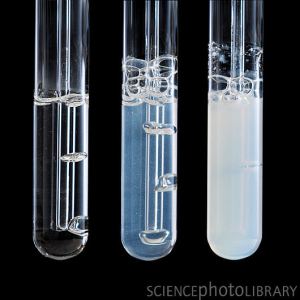How does carbon dioxide react with limewater ?
1 Answer
Carbon dioxide reacts with limewater to form calcium carbonate, which precipitates out of the solution.
Explanation:
The reaction between limewater, which is a solution of calcium hydroxide,
The solution will turn milky due to the fact that calcium carbonate is a white precipitate. This reaction is actually used to test for the presence of carbon dioxide.
An unknown gas is bubbled through a solution of calcium hydroxide - if the solution turns cloudy, then the unknown gas is carbon dioxide.
If you continue to bubble the carbon dioxide through the limewater another acid - base reaction occurs which results in the precipitate dissolving to give soluble calcium hydrogen carbonate:
This is how naturally ocurring acid rain is able to chemically erode limestone resulting in cave formation.
When this solution evaporates the reverse reaction occurs resulting in the formation of stalactites and stalagmites.

Read more about this reaction here:
A cool video on this reaction:


